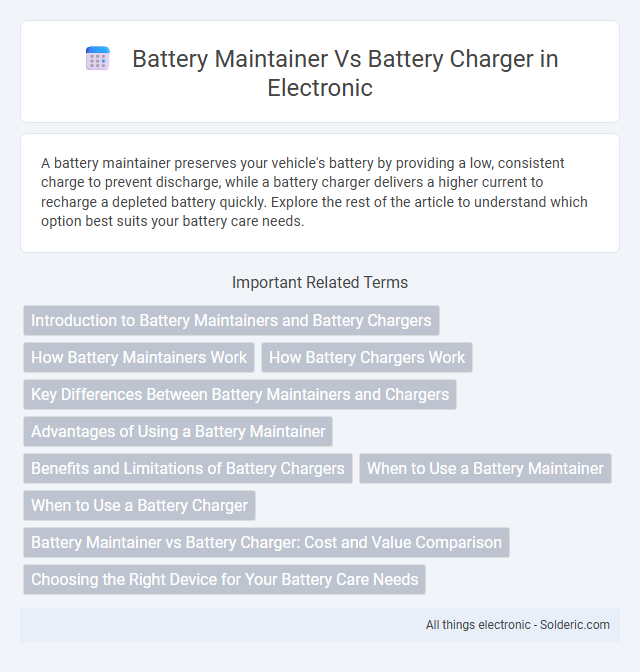A battery maintainer preserves your vehicle's battery by providing a low, consistent charge to prevent discharge, while a battery charger delivers a higher current to recharge a depleted battery quickly. Explore the rest of the article to understand which option best suits your battery care needs.
Comparison Table
| Feature | Battery Maintainer | Battery Charger |
|---|---|---|
| Purpose | Maintains battery charge over long periods | Recharges depleted battery quickly |
| Charging Speed | Slow, trickle charge | Fast to moderate |
| Usage | Preserves battery health during storage | Restores battery power for immediate use |
| Current Output | Low amperage, typically under 2 amps | Higher amperage, often 2-10 amps or more |
| Automatic Shutoff | Usually features automatic float mode | May or may not have automatic shutoff |
| Battery Types Supported | Works with lead-acid, AGM, gel, and lithium | Varies by model, generally supports multiple types |
| Ideal For | Seasonal vehicles, long-term storage | Dead or low batteries needing recharge |
Introduction to Battery Maintainers and Battery Chargers
Battery maintainers and battery chargers serve distinct roles in vehicle battery care; a battery maintainer keeps your battery at optimal charge over long periods without overcharging, while a battery charger delivers a higher current to recharge a depleted battery quickly. Battery maintainers are ideal for vehicles in storage or infrequent use, preserving battery life by compensating for self-discharge. In contrast, battery chargers are designed for faster restoration of battery capacity, essential when a battery is significantly drained and needs immediate powering up.
How Battery Maintainers Work
Battery maintainers work by delivering a low, steady voltage to your battery, preventing it from discharging while maintaining optimal charge levels without overcharging. They use smart, automatic charging technology that monitors battery voltage and adjusts the charge accordingly to extend battery life and ensure readiness. This makes battery maintainers ideal for vehicles or equipment stored for long periods, where maintaining a full charge is crucial.
How Battery Chargers Work
Battery chargers work by converting AC power from a wall outlet into the appropriate DC voltage needed to restore a battery's charge safely and efficiently. They regulate current flow to prevent overcharging, using different charging modes such as trickle or fast charging based on battery type and condition. Understanding how battery chargers work helps you optimize battery lifespan and ensure your devices remain powered reliably.
Key Differences Between Battery Maintainers and Chargers
Battery maintainers are designed to provide a low, steady charge that prevents battery drain and keeps your battery at full capacity over long periods without overcharging. Battery chargers, on the other hand, deliver a higher voltage current to quickly restore a depleted battery's charge but are not intended for continuous use. Your choice depends on whether you need to maintain a battery's charge over time or rapidly recharge a deeply discharged battery.
Advantages of Using a Battery Maintainer
A battery maintainer carefully regulates voltage and current to keep your battery at optimal charge without overcharging, extending battery life and ensuring reliable performance. Unlike traditional battery chargers that recharge depleted batteries quickly but can cause overheating or damage if misused, maintainers provide a safe, continuous trickle charge ideal for vehicles stored long-term. This controlled approach helps prevent battery sulfation, preserving capacity and saving you replacement costs over time.
Benefits and Limitations of Battery Chargers
Battery chargers provide the benefit of quickly restoring a battery's charge, making them ideal for regular use when rapid battery replenishment is needed. Limitations include the potential for overcharging or heat damage if the charger lacks automatic shut-off features, which can reduce battery lifespan. You should choose a charger with built-in safety mechanisms to ensure efficient and safe battery restoration.
When to Use a Battery Maintainer
A battery maintainer is ideal when you need to keep your vehicle's battery at a full charge over extended periods of inactivity, such as during seasonal storage or infrequent use. Unlike a standard battery charger that rapidly replenishes a drained battery, a maintainer provides a low, steady current to prevent self-discharge and battery damage. You should use a battery maintainer to prolong battery life and ensure your vehicle starts reliably after long storage intervals.
When to Use a Battery Charger
A battery charger is ideal when your battery is deeply discharged or completely dead, as it delivers a higher voltage and current to restore power quickly. Use a charger when you need to recharge your car, motorcycle, or boat battery in a relatively short time, typically hours rather than days. Your battery maintainer, in contrast, is best suited for long-term use to keep a fully charged battery at optimal capacity without overcharging.
Battery Maintainer vs Battery Charger: Cost and Value Comparison
Battery maintainers generally cost more upfront but deliver long-term value by preventing battery deterioration and extending battery life through controlled, low-voltage charging. Battery chargers offer a lower initial price but lack the sophisticated regulation and continuous maintenance features, leading to potential early battery replacement costs. Investing in a battery maintainer provides a cost-effective solution for preserving battery health, especially for vehicles or equipment used infrequently.
Choosing the Right Device for Your Battery Care Needs
Choosing the right device for your battery care depends on your usage patterns and the battery type. A battery charger delivers a higher current to quickly restore battery power, ideal for dead or severely drained batteries, while a battery maintainer provides a low, consistent charge to keep your battery at optimal capacity over long periods. Your choice should consider whether you need rapid charging or long-term maintenance to prolong battery life effectively.
Battery maintainer vs Battery charger Infographic

 solderic.com
solderic.com